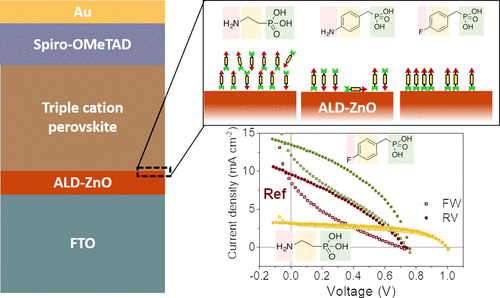当前位置:
X-MOL 学术
›
ACS Appl. Energy Mater.
›
论文详情
Our official English website, www.x-mol.net, welcomes your
feedback! (Note: you will need to create a separate account there.)
Chemical Passivation with Phosphonic Acid Derivatives of ZnO Deposited by Atomic Layer Deposition and Its Influence on the Halide Perovskite Interface
ACS Applied Energy Materials ( IF 5.4 ) Pub Date : 2021-06-04 , DOI: 10.1021/acsaem.1c00612 Olivier Fournier 1, 2 , Claire Darin Bapaume 2, 3 , Davina Messou 2, 4 , Muriel Bouttemy 2, 4 , Philip Schulz 2, 3 , François Ozanam 5 , Laurent Lombez 2, 3 , Nathanaelle Schneider 2, 3 , Jean Rousset 1, 2
ACS Applied Energy Materials ( IF 5.4 ) Pub Date : 2021-06-04 , DOI: 10.1021/acsaem.1c00612 Olivier Fournier 1, 2 , Claire Darin Bapaume 2, 3 , Davina Messou 2, 4 , Muriel Bouttemy 2, 4 , Philip Schulz 2, 3 , François Ozanam 5 , Laurent Lombez 2, 3 , Nathanaelle Schneider 2, 3 , Jean Rousset 1, 2
Affiliation

|
We report on the modification of zinc oxide thin films deposited by atomic layer deposition (ALD-ZnO) with various phosphonic acid derivatives. Particularly, three molecules differing by their spacer and functionalizing groups were tested: 2-aminoethylphosphonic acid (2-AEPA), 4-aminobenzylphosphonic acid, and 4-fluorobenzylphosphonic acid (4-FBzPA). The resulting surfaces were investigated with surface-sensitive characterization techniques such as X-ray photoelectron spectroscopy and attenuated total reflection IR spectroscopy. We find differences in the phosphonic acid film growth, mostly driven by the nature of the functionalizing group: the amine-based molecules tend to cover the surface with disordered layers or multilayers, whereas the 4-FBzPA layer rather exhibits features of a monolayer. Finally, 2-AEPA and 4-FBzPA have been used as a mean to passivate the reactive interface between ALD-ZnO and a hybrid organic inorganic metal halide perovskite. Morphological and structural studies were carried out with scanning electron microscopy and X-ray diffraction, and solar cells using these layers as electron transport layers were synthesized. With the highest power conversion efficiency of 4.1%, the direct application of these surface modifications into complete devices is shown not to be enough to achieve high-efficiency solar cells with ALD-ZnO.
中文翻译:

用原子层沉积法沉积的 ZnO 的膦酸衍生物化学钝化及其对卤化物钙钛矿界面的影响
我们报告了用各种膦酸衍生物对原子层沉积 (ALD-ZnO) 沉积的氧化锌薄膜进行改性。特别是,测试了三个不同的分子,它们的间隔基和官能团是不同的:2-氨基乙基膦酸 (2-AEPA)、4-氨基苄基膦酸和 4-氟苄基膦酸 (4-FBzPA)。使用表面敏感表征技术(例如 X 射线光电子能谱和衰减全反射红外光谱)研究所得表面。我们发现膦酸膜生长的差异,主要是由官能团的性质驱动的:基于胺的分子倾向于用无序层或多层覆盖表面,而 4-FBzPA 层则表现出单层的特征。最后,2-AEPA 和 4-FBzPA 已被用作钝化 ALD-ZnO 和混合有机无机金属卤化物钙钛矿之间的反应界面的手段。使用扫描电子显微镜和 X 射线衍射进行了形态和结构研究,并合成了使用这些层作为电子传输层的太阳能电池。凭借 4.1% 的最高功率转换效率,将这些表面改性直接应用到完整的器件中并不足以实现具有 ALD-ZnO 的高效太阳能电池。
更新日期:2021-06-28
中文翻译:

用原子层沉积法沉积的 ZnO 的膦酸衍生物化学钝化及其对卤化物钙钛矿界面的影响
我们报告了用各种膦酸衍生物对原子层沉积 (ALD-ZnO) 沉积的氧化锌薄膜进行改性。特别是,测试了三个不同的分子,它们的间隔基和官能团是不同的:2-氨基乙基膦酸 (2-AEPA)、4-氨基苄基膦酸和 4-氟苄基膦酸 (4-FBzPA)。使用表面敏感表征技术(例如 X 射线光电子能谱和衰减全反射红外光谱)研究所得表面。我们发现膦酸膜生长的差异,主要是由官能团的性质驱动的:基于胺的分子倾向于用无序层或多层覆盖表面,而 4-FBzPA 层则表现出单层的特征。最后,2-AEPA 和 4-FBzPA 已被用作钝化 ALD-ZnO 和混合有机无机金属卤化物钙钛矿之间的反应界面的手段。使用扫描电子显微镜和 X 射线衍射进行了形态和结构研究,并合成了使用这些层作为电子传输层的太阳能电池。凭借 4.1% 的最高功率转换效率,将这些表面改性直接应用到完整的器件中并不足以实现具有 ALD-ZnO 的高效太阳能电池。

































 京公网安备 11010802027423号
京公网安备 11010802027423号